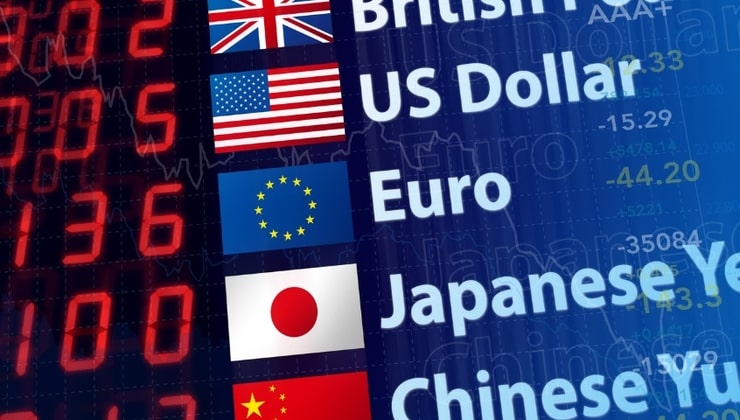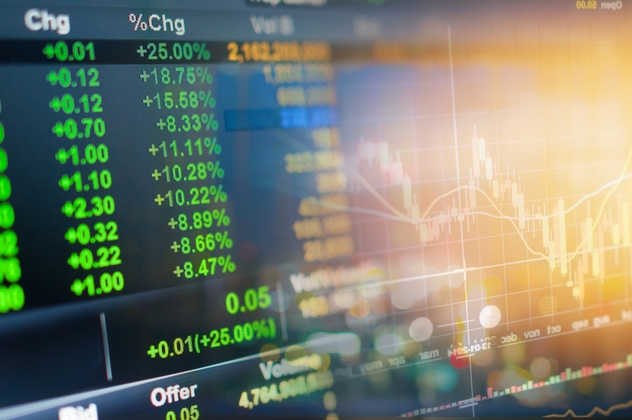- English
- 中文版

Written by: Rael Tooch | Expert Financial Writer
What are the most traded currency pairs in the world?
The foreign exchange (margin FX) market is the world's largest and most liquid financial market, with an estimated daily turnover exceeding $6 trillion. Margin FX trading involves buying and selling currency pairs representing the exchange rate between two currencies. Some currency pairs are more actively traded than others due to their liquidity, stability, and the economic power of the countries behind the currencies. This article delves into the most traded currency pairs, examining the factors that make them so popular and exploring how various economic and geopolitical factors influence their price movements.
Understanding these currency pairs and the forces driving their fluctuations is crucial for traders to make informed decisions in the highly dynamic world of margin FX trading. The sections below will discuss key insights into the most traded pairs, the best times to trade them, and the economic indicators that move their prices, offering a clear perspective for traders at all levels.
The most traded currency pairs
The most traded currency pairs in the margin FX market typically involve the US dollar (USD) and other major currencies such as the Euro (EUR), Japanese Yen (JPY), British Pound (GBP), Swiss Franc (CHF), Australian Dollar (AUD), and Canadian Dollar (CAD). The most commonly traded pairs include:
- EUR/USD: Euro vs US Dollar
- USD/JPY: US Dollar vs Japanese Yen
- GBP/USD: British Pound vs US Dollar
- USD/CHF: US Dollar vs Swiss Franc
- AUD/USD: Australian Dollar vs US Dollar
- USD/CAD: US Dollar vs Canadian Dollar
These pairs, often called the "majors," represent the bulk of daily margin FX trading volume and are preferred by traders for their liquidity and stability. The USD's dominance is a result of its role as the world’s reserve currency and its involvement in global trade and finance.
Why are these currency pairs the most traded?
The popularity of these currency pairs can be attributed to the size and influence of the economies backing them. The US, Eurozone, Japan, and the UK are some of the world’s largest economies, leading to significant demand for their respective currencies. These economies provide a wealth of economic data and transparency in monetary policy, making them attractive to traders. Moreover, the widespread use of the USD in global trade ensures its presence in most transactions, further driving the trading volume of pairs like EUR/USD, USD/JPY, and GBP/USD.
Factors influencing the volatility of the most traded currency pairs
Various factors, including economic data releases, interest rate decisions, and central bank policies, drive the volatility of the most traded currency pairs. For instance, inflation, employment, or GDP data fluctuations can lead to significant movements in these pairs. While high liquidity tends to reduce overall volatility, major economic surprises or geopolitical events can still cause sharp price swings in the margin FX market.
The impact of geopolitical events on the most traded pairs
Geopolitical events such as trade tensions, military conflicts, and political instability can influence the most traded currency pairs, though the degree of impact varies depending on the specific event. Safe-haven currencies like the US Dollar and the Swiss Franc often see increased demand during global uncertainty. However, the effect on currency pairs such as USD/JPY or USD/CHF may differ based on market sentiment and the nature of the geopolitical event. For instance, safe-haven demand can cause movements, but the magnitude of these changes depends on how traders perceive the risks involved.
Best times to trade the most traded currency pairs
While the margin FX market operates 24 hours a day, the best times to trade the most traded currency pairs are during periods of high market activity, such as the London and New York sessions. The overlap between these sessions provides the greatest liquidity, particularly for USD, EUR, and GBP pairs. Trading during these high-volume periods often leads to tighter spreads and greater opportunities for profit as market participants actively engage in trading.However, rapid price movements can also lead to quick losses if traders aren't careful.
Currency pairs with the highest liquidity
EUR/USD stands out as the most liquid among the most traded currency pairs. The large economies of the US and Eurozone, coupled with the volume of trade between them, contribute to this pair’s significant liquidity. Other pairs, such as USD/JPY and GBP/USD, also exhibit high liquidity, making them favourites among traders who seek quick execution and narrow spreads.
Spreads between the most traded currency pairs
One key advantage of trading the most traded currency pairs is the lower spreads, especially during periods of peak liquidity. For instance, EUR/USD often offers the tightest spreads, followed by pairs like USD/JPY and GBP/USD. Tighter spreads result in lower transaction costs, benefiting traders who engage in frequent trading.
How interest rate changes impact the most traded currency pairs
Central bank interest rate changes play a crucial role in the value of currencies. Higher interest rates tend to attract foreign investment, strengthening a country’s currency. Conversely, lower interest rates typically result in currency depreciation. Traders pay close attention to interest rate announcements from the US Federal Reserve, the European Central Bank, the Bank of Japan, and others to anticipate potential movements in the most traded currency pairs.
The role of economic indicators
Economic indicators, such as inflation, unemployment, and GDP growth, provide vital insight into a country’s financial health. Traders of the most traded currency pairs closely monitor these indicators, as they often drive price movements in the margin FX market. For example, strong employment data in the US could result in a bullish move for USD-based pairs, while weak data might trigger a sell-off.
Market sentiment and its influence on currency movements
Market sentiment reflects investors' overall attitude toward a particular currency or market. Positive sentiment can lead to currency appreciation, while negative sentiment can result in a sell-off. For the most traded currency pairs, market sentiment is influenced by economic data, geopolitical events, and central bank policies. Understanding market sentiment is crucial for traders to position themselves effectively.
Correlations between currency pairs and other financial markets
The most traded currency pairs can exhibit correlations with other financial markets, such as equities and commodity CFDs. For example, due to Australia's significant role as a commodity CFD exporter, AUD/USD often shows a correlation with commodity CFD prices, especially gold. However, this correlation is not always consistent and may break down during periods of market volatility or shifts in broader economic trends. Traders should be mindful of these correlations but not rely solely on them when making trading decisions.
The role of the USD in the most traded pairs
The US dollar’s role as the world’s reserve currency makes it a central player in the margin FX market. Most major currency pairs involve the USD, and its movements can have far-reaching implications across the global economy. Changes in US monetary policy, economic data, and geopolitical events often profoundly impact USD-based currency pairs.
Benefits of trading the most traded currency pairs
The most traded currency pairs offer advantages for margin FX traders, including high liquidity, tight spreads, and abundant market data. These factors make it easier for traders to enter and exit positions efficiently, reducing transaction costs and improving the overall trading experience. Furthermore, the stability of these pairs makes them less susceptible to extreme volatility compared to less traded or exotic pairs.
Key economic calendars to follow
Traders focusing on the most traded currency pairs must stay informed about upcoming economic events. Key economic calendars, which track central bank meetings, economic data releases, and geopolitical developments, are essential tools for monitoring events that could impact the margin FX market. Keeping a close eye on these calendars allows traders to anticipate market movements and adjust their strategies accordingly.
The most traded currency pairs play a pivotal role in the global margin FX market, driven by the economic strength of the countries they represent. Understanding the factors influencing these pairs, from interest rates and economic indicators to geopolitical events and market sentiment, is essential for any trader navigating the margin FX market successfully. With high liquidity, tight spreads, and abundant market data, these pairs offer traders significant opportunities to capitalise on market movements. However, staying informed and following key economic events are critical to sound trading decisions.
FAQs
What factors should beginners consider when choosing currency pairs to trade?
Beginners should start with currency pairs that offer high liquidity and tighter spreads, such as EUR/USD or USD/JPY. While these pairs are generally more stable due to their high liquidity, they can also exhibit sharp price movements during major economic events or announcements. As a result, beginners should be aware that even highly liquid pairs can become volatile. The abundance of market analysis and data available for these major pairs can help new traders make more informed decisions, but a cautious approach is recommended when trading during high-impact events.
Are there advantages to trading currency pairs outside of the major pairs?
While major pairs are the most traded due to liquidity, some traders focus on minor or exotic pairs, which can offer higher volatility and potentially larger gains. However, these pairs often come with wider spreads and greater risk. Trading non-major pairs requires careful strategy and an understanding of the economies involved.
How does news trading impact currency pair movements?
News trading refers to trading based on economic data releases or geopolitical events. Major announcements, like GDP figures, unemployment rates, or central bank meetings, can cause significant short-term movements in currency pairs. Traders often position themselves ahead of these releases or react quickly to capitalise on price fluctuations.
What role do central bank policies play in currency trading?
Central bank policies, such as monetary tightening or loosening, directly influence currency values. For example, when a central bank raises interest rates to curb inflation, the currency typically strengthens as higher rates attract foreign capital. Conversely, if a central bank cuts rates, the currency often weakens due to reduced investor demand.
Can currency pairs correlate with commodity CFD or share CFDs?
Yes, some currency pairs have correlations with commodity CFD or share CFDs markets. For instance, due to Australia's significant role as a commodity CFD exporter, AUD/USD often correlates with commodity CFD prices, especially gold. Similarly, currencies like the Canadian Dollar (CAD) may move with oil prices. Understanding these relationships can help traders predict currency movements based on trends in other markets.
Related articles
The material provided here has not been prepared in accordance with legal requirements designed to promote the independence of investment research and as such is considered to be a marketing communication. Whilst it is not subject to any prohibition on dealing ahead of the dissemination of investment research we will not seek to take any advantage before providing it to our clients. Pepperstone doesn’t represent that the material provided here is accurate, current or complete, and therefore shouldn’t be relied upon as such. The information, whether from a third party or not, isn’t to be considered as a recommendation; or an offer to buy or sell; or the solicitation of an offer to buy or sell any security, financial product or instrument; or to participate in any particular trading strategy. It does not take into account readers’ financial situation or investment objectives. We advise any readers of this content to seek their own advice. Without the approval of Pepperstone, reproduction or redistribution of this information isn’t permitted.

